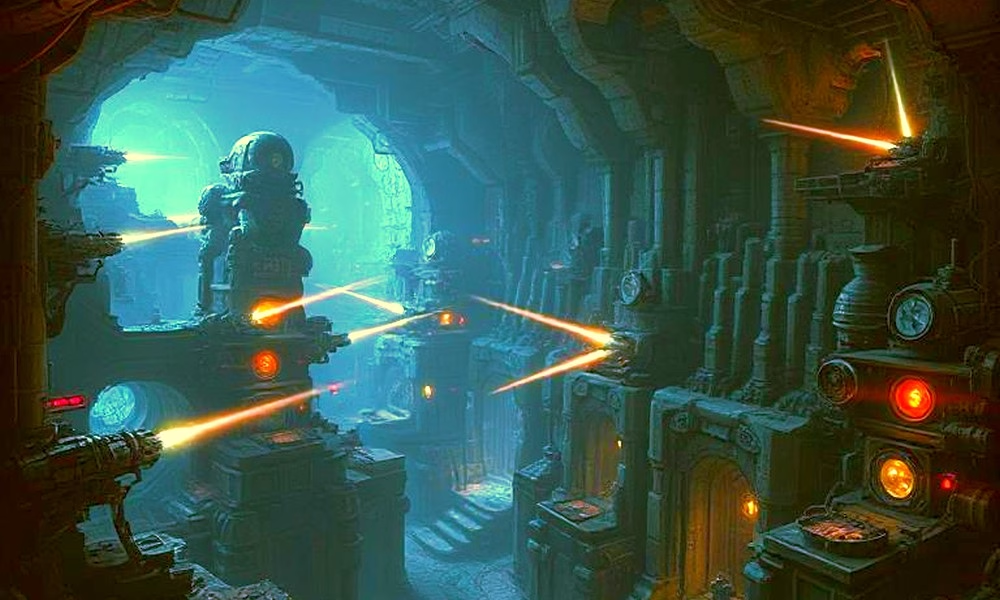
In the mid-1940s, America was introduced to a bizarre, fascinating, and totally off-the-rails idea known as The Shaver Mystery. According to its creator, Richard Sharpe Shaver, Earth’s ancient caverns are populated by sinister beings called “Deros” — degenerate descendants of an ancient alien race — who use bizarre ray machines to torment surface humans with mental and physical pain.
Yes, you read that correctly. Evil cave-dwelling robot-aliens with mind-ray guns were supposedly responsible for most of humanity’s ills, from accidents and diseases to wars and serial killers.
The claim, published in pulp science fiction magazines, blurred the line between fantasy, science fiction, and alleged firsthand experience — sparking a phenomenon that would influence UFO culture, conspiracy theories, and hollow earth myths for decades.
The Shaver Mystery debuted in 1945 in the magazine Amazing Stories, then edited by Raymond A. Palmer. Palmer received a strange letter from Shaver, who claimed he had discovered an ancient language called “Mantong” that revealed secret meanings in every word. Intrigued (or at least recognizing good copy when he saw it), Palmer encouraged Shaver to expand on his claims.
What followed was a sprawling story titled “I Remember Lemuria!” — a mix of sci-fi pulp and Shaver’s personal visions. It detailed how once-great ancient beings, the Elder Races, abandoned Earth after environmental catastrophe. They left behind two classes of subterranean survivors: Teros: the good guys, who tried to protect humanity; and Deros: the corrupted, evil ones who lived underground, operated bizarre machinery, and broadcast “pain rays” and “thought control beams” into human minds.
And according to Shaver, this wasn’t just fiction. He insisted it was true.
Palmer published the story with gusto — and Amazing Stories’ circulation skyrocketed. For a brief moment in the late 1940s, Shaver’s caverns were the talk of sci-fi fandom.
The Shaver Mystery has faded from mainstream attention, but its DNA can still be found scattered throughout modern conspiracy culture:
- Hollow Earth theories.
- Underground alien bases (think Area 51 rumors).
- Mind control fears.
- Tales of secret ancient civilizations influencing humanity.
The Shaver Mystery also marks one of the earliest examples of a now-familiar pattern: the blending of fringe science fiction with alleged “real experiences” to create pseudo-realities.
In a way, it was a proto-UFO mythology, laying groundwork for later claims about alien abductions, government mind control experiments, and cosmic cover-ups.
Today, Shaver’s stories are mostly viewed as a curious footnote in American pseudoscience and pulp history — but they were a cultural phenomenon in their time, blurring the line between storytelling and belief in a way that prefigured many later fringe movements.
Important Facts, Figures, and Characters
- Richard Sharpe Shaver (1907–1975): A welder and artist who suffered from mental health struggles throughout his life, including hearing disembodied voices. Shaver believed he was uniquely attuned to the Deros’ activities and that his revelations were not fiction, but fact.
- Raymond A. Palmer (1910–1977): Editor of Amazing Stories and later founder of Fate Magazine. Palmer was a brilliant marketer and enthusiast for the strange — some say he cynically milked the Shaver Mystery for sales, while others argue he was genuinely fascinated.
- “I Remember Lemuria!” (1945): The landmark story that launched the Shaver Mystery phenomenon. Despite (or because of) its wild claims, it helped double the magazine’s circulation and turned Amazing Stories into a cultural touchstone for a few wild years.
- Reader Letters: After publishing Shaver’s tales, Amazing Stories was flooded with thousands of letters from readers who claimed to have seen Deros, heard strange underground noises, or had unexplained psychic experiences. Some readers insisted Shaver’s stories explained lifelong mysteries in their own lives.
- Decline: As interest waned in the 1950s, and mainstream science fiction turned more “serious,” Shaver’s reputation collapsed. Many writers and fans distanced themselves from the Mystery, dismissing it as a blend of mental illness and cynical publishing tactics.
The Lighter Side
The Shaver Mystery stands out for just how creative it was. We’re talking about:
- Robots that looked like toasters with arms.
- Ancient ray guns that could “make you stub your toe on purpose.”
- Cavern cities lit by glowing rocks and populated by grotesque mutants who hated daylight.
- Earth being hollow — not just a little hollow, but Swiss cheese hollow, with massive tunnels and cities below every major surface feature.
It reads like a fever dream fueled by Flash Gordon serials, Lovecraftian horror, and a very loose relationship with scientific plausibility. But that’s what made it so magnetic.
At its heart, the Shaver Mystery was fun. Terrifying fun, sure, but fun — and it scratched a deep itch for people yearning for mysteries bigger than themselves, especially in a postwar world that was rapidly being “explained” by science.
Final Verdict
The Shaver Mystery is a vivid, colorful example of how myth, mental health, marketing, and mass media can collide to create a new kind of pseudoscience.
While there’s zero evidence for Deros, Teros, or underground pain rays, Shaver’s wild visions continue to echo in conspiracy culture.
And honestly? If there were evil robot creatures under the Earth’s surface firing mind beams at us…it would explain a lot about rush hour traffic.




